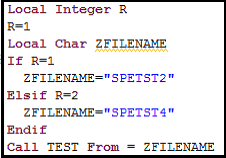While working around the complex functionality, it’s very obvious that you may have to deal with the
Multiple source files. Multiple file may define the function with same name but with different set of instruction on the same event or the action and you may want call same function from particular file based on some condition on run time and also want to encapsulate the file name.
Code which helps you for Calling Function from Different File’s Using Single Call Statement and Encapsulation.
The above code will invoke the TEST sub program from the SPETST2 file, if you have noticed that the different file name is getting encapsulated in the variable ZFILENAME based on certain condition and single statement is enough to call a function from a particular file.
